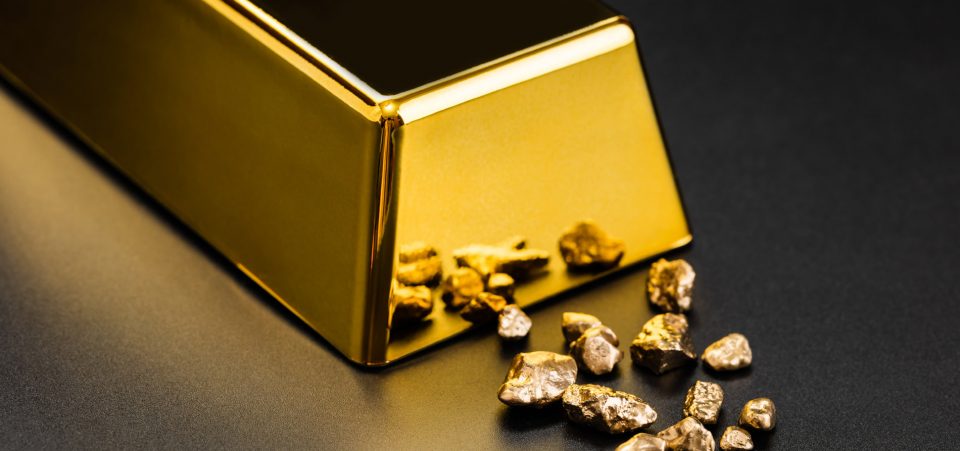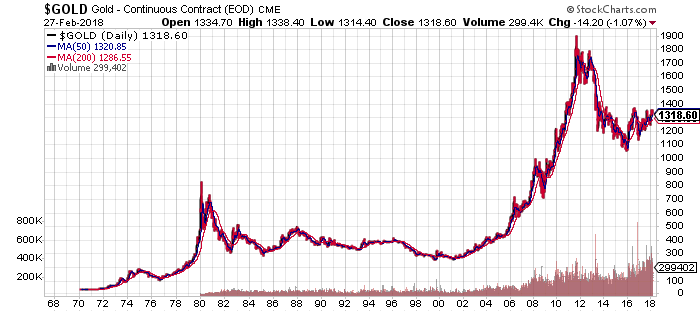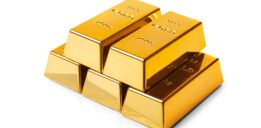Inflation Is Back and Risks Are High, But This Is Why the Gold Price Is Not Reacting
Federal Reserve Chair Jerome Powell delivered his first testimony before Congress. Investors all over the world had waited anxiously for his words. Many, given the huge leverage that exists in stocks now, wanted to discover where interest rates are going. Unfortunately, Powell was not clear. He praised the U.S. economy and all but confirmed expectations that he would follow the approach that his predecessor, Janet Yellen, established. Are there any hints in his testimony about what direction the gold price will take?
The key is inflation expectations. Normally, high inflation pushes investors toward precious metals and so-called safe assets. The gold price goes up in such circumstances but not immediately. For almost a decade now, central banks in the United States (the Fed), in Europe, and in Japan—to mention a few—have run highly unusual and “generous” interest rate policies.
The rates were so low—in Europe, they remain near zero—that economists have lamented the lack of inflation as a problem. Indeed, it is a problem. No inflation means no economic growth. Yet, these same economists have turned on the proverbial dime now.
Suddenly, inflation is a problem again. From zero, we’re told it’s steadily rising and approaching 2.1%, based on year-on-year consumer price index statistics. But in January alone, it rose 0.5%. (Source: “Rise in U.S. inflation puts spotlight on Fed’s Powell,” Reuters, February 14, 2018.)
The Banks Want Higher Rates
Banks, of course, can’t wait for the Fed Chair to send off warnings about inflation. They’re itching to increase the cost of borrowing to consumers. Businesses won’t have to worry as much about interest rates because the tax cuts that Congress passed at the end of 2017 benefit them disproportionately compared to individuals.
Powell expressed confidence in the U.S. economy. He didn’t seem too anxious to raise rates. The problem, however, is that the U.S. dollar is falling compared to all other major currencies. The EURUSD exchange rate now is $1.23. At the start of 2017, all expectations were for the dollar to achieve parity with the euro. The reverse has happened. And note that the rate is bound to increase sharply when (not if) the European Central Bank (ECB) abandons quantitative easing. Mario Draghi, the current ECB president, is due to resign in late 2019.
To recapitulate: U.S. interest rates will go up. Powell did not say anything that would contradict this expectation. The higher rates should drive the dollar higher. That’s why gold has been hesitating to reach the next ceiling of $1,400 per ounce.
Low Interest Rates Have Distorted Traditional Economic Mechanisms
In the not-so-distant past—it has become necessary to categorize current economic history into before and after the 2008 crisis—interest rates were much higher than they are now. But the entire economic machine, globally, has gotten used to, or addicted to, cheap debt. That explains why a slight increase in inflation and rates going up three times at 0.25% intervals scares so many.
Not long ago, rates of five percent to seven percent were considered cheap, even a bargain. Thus, when inflation rose, there was less wiggle room to raise rates. Doing so would inevitably trigger a recession. In that climate, gold prices could thrive.
To most investors, inflation meant it was time to get into gold. Yet if the Fed suddenly resumed that interest regimen, it would make the economy collapse. The Dow Jones would crash at freefall acceleration, leaving investors and the market in the dust. In the early 2000’s, interest rates were considered moderate. But they increased sharply in 2006-2007, triggering the infamous subprime crisis and the 2018 financial crash that led to the Great Recession.
Chart courtesy of StockCharts.com
Gold reached its highest prices ever from 2000 to 2011. That was before the low interest rates. And the dollar was trading much lower than today based on the dollar index.
Where Does Gold Fit into This?
The missing element that made gold rise sharply from 2003-2011 was part of a wider pattern of commodity speculation. But it was also a response to investors’ search and demand for safe assets. The other one is the sudden appeal of Bitcoin and other cryptocurrencies, which have stolen the shine from gold. But that won’t last long.
The U.S. became involved in two wars: Afghanistan and Iraq. The United States is still involved in those same wars now, but it has since added Syria and Yemen. In 2018, it could add North Korea and Iran, while high officials in the administration are openly speaking about a return to the Cold War with the old superpower, Russia, and the new superpower, China. (Source: “Military Shifts Focus to Threats by Russia and China, Not Terrorism”, The New York Times, January 19, 2018.)
Therefore, all the elements exist for gold to rally. And it would, if it weren’t for the anomaly in central bank interest rate policies of the past few years. Still, Fed Chair Powell’s words bode well for the gold price in 2018. Many expected the pace of the rate hikes to be faster and sharper, due to the inflation fears and the corresponding boost effect it would have on the dollar.
High Dollar, Low Gold Goes the Refrain. But The Dollar Ain’t Going Up
The gold price remains firmly within the $1,300-per-ounce boundaries. It could soon test the $1,350 resistance after reaching a high of $1,365 per ounce in 2018 already. Powell has indicated he plans to raise rates three times in 2018. Many mused four hikes. The Fed Chair also muted fears of labor market increases and inflation. Indeed, there’s little or no inflation coming from salaries.
All the tax cuts benefits have gone to the already rich, who don’t need further incentives to consume. The fact that the Fed rate has stayed firm at 1.5% while residential mortgage and other commercial rates have already gone up in anticipation of Fed hikes should serve as an additional signal that inflation rise concerns are misguided as far as the real economy is concerned.
Overall, the tone of the economy is one of uncertainty. There are big risks on the horizon and major shifts already occurring at the macro level. The playing field is set for a gold rally in 2018.







